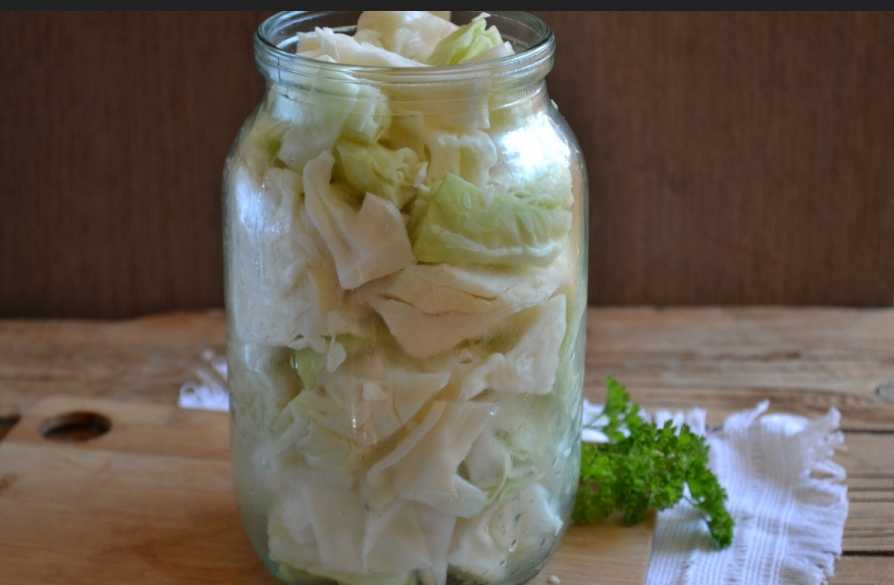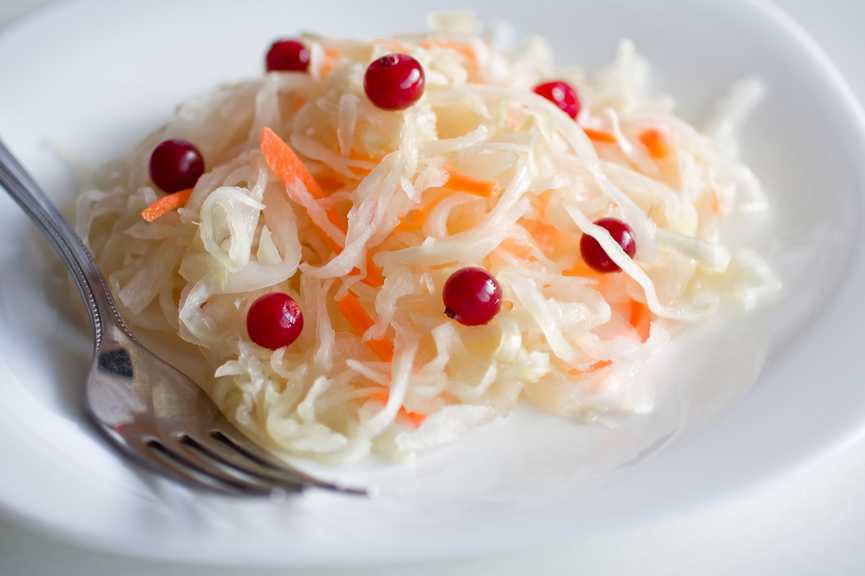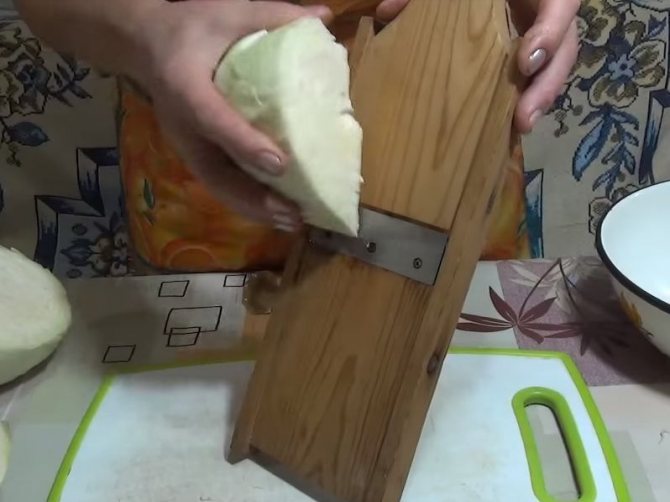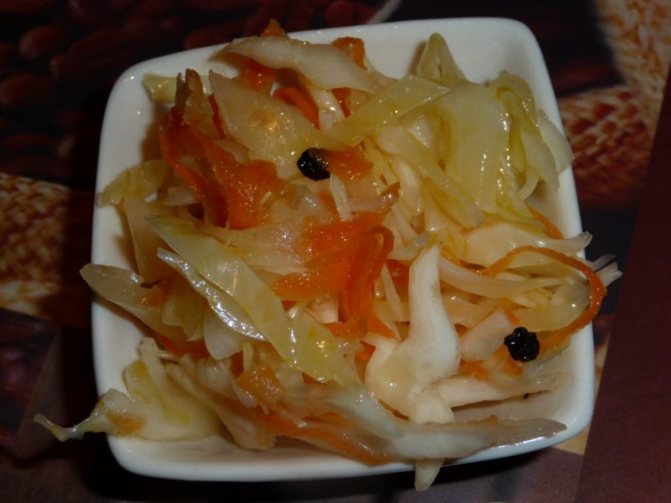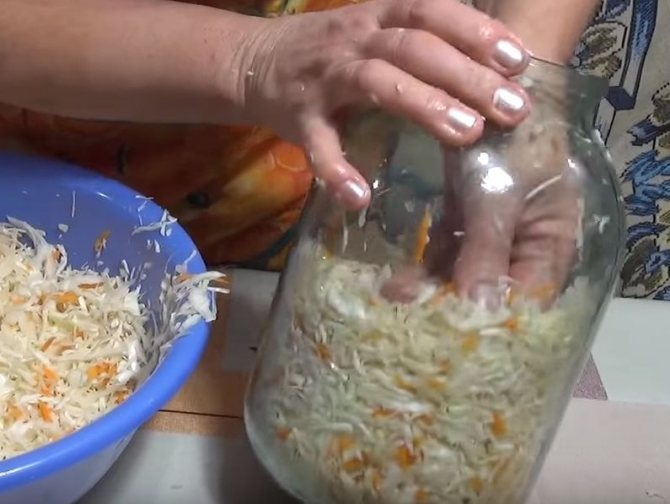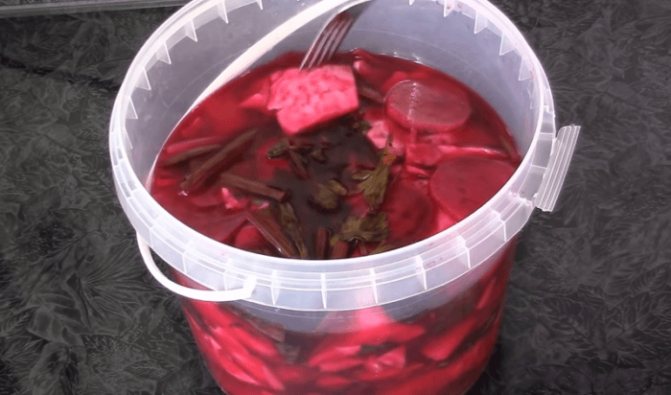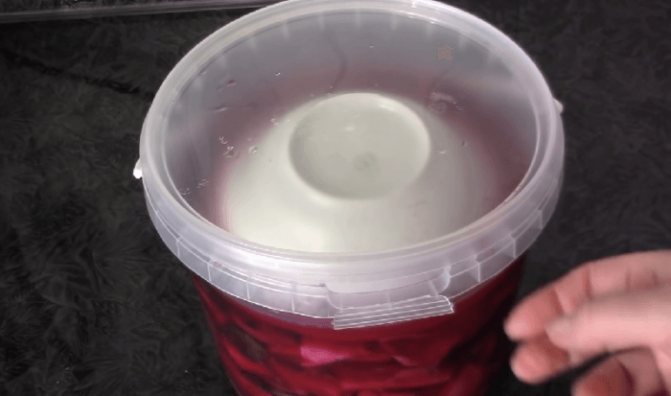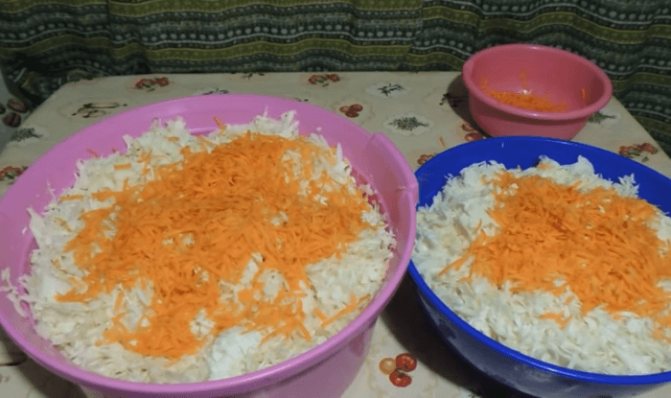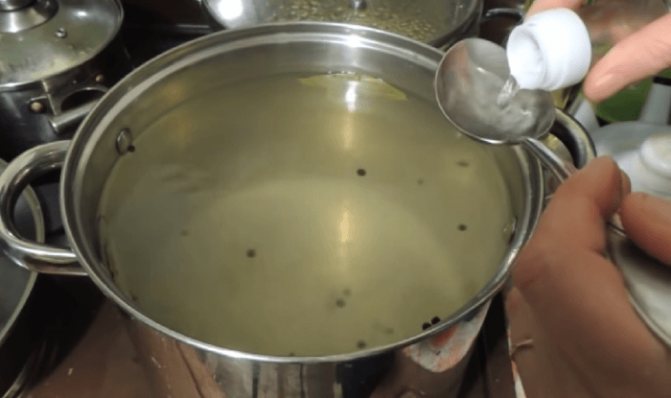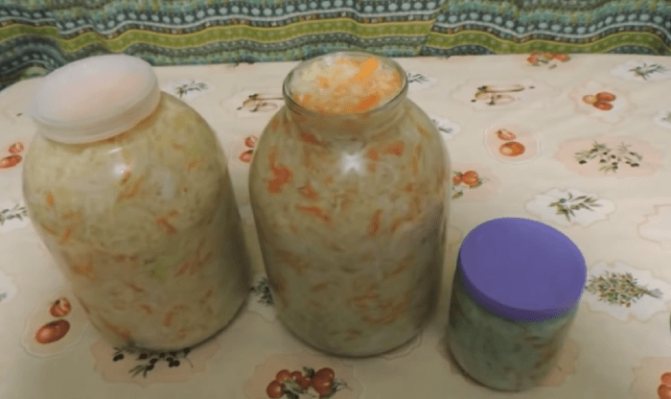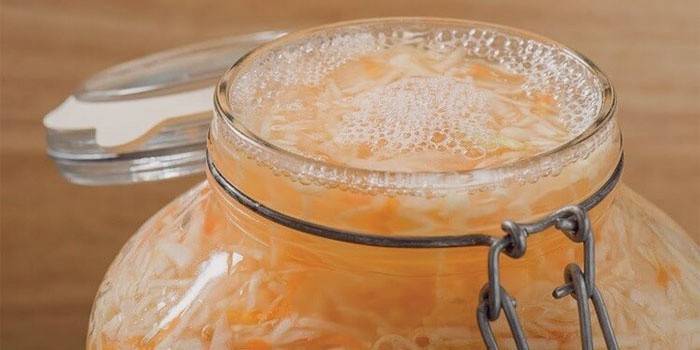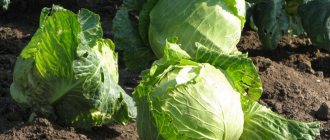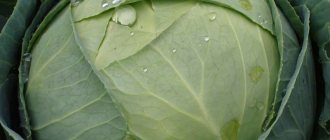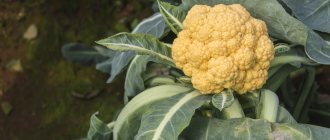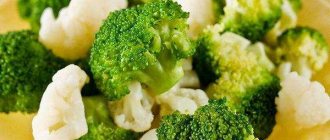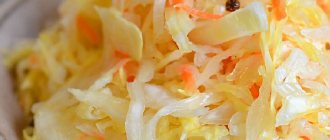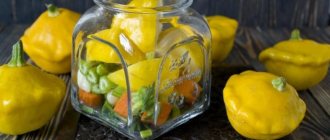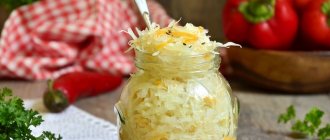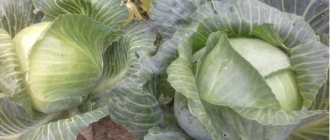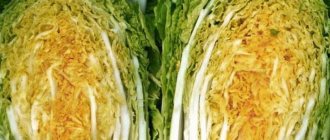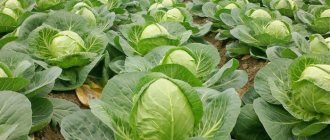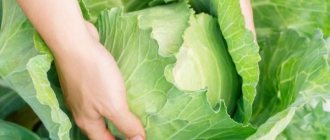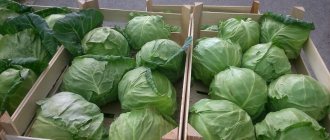Cabbage varieties for pickling
The process of salting, pickling cabbage is very simple and accessible to everyone. Grandfather's classic sauerkraut recipe requires only the cabbage itself, carrots, and salt. Cabbage and carrots are chopped, mixed with salt and put under pressure.
After three days, cabbage can be placed in jars, closed with simple plastic lids and stored in a cool place throughout the winter.
Nowadays, various spices are used for pickling cabbage: pepper, bay leaves, onions, caraway seeds, cloves. Cabbage is often salted with beets or apples.
There are dozens of recipes for pickling cabbage, but in any of them, the main ingredients remain the same.
Crispy salted cabbage in a jar
This recipe can be prepared all year round. Even in winter, having delivered forks of cabbage and a couple of carrots, you can cook it in no time. If you don't have the opportunity to store a whole crop, stock up on it in the form of this wonderful snack for the winter.
Ingredients:
- 2 kilograms of cabbage (it is better to choose late varieties, the dish from them will turn out to be more crispy);
- 1-2 carrots;
- 2 lavrushkas;
- a little peppercorn mixture;
- 40-50 grams of salt;
- 2 teaspoons of granulated sugar.
Step by step description of the recipe:
Cut the cabbage into thin strips with a knife or shredder. Grate the carrots in the same way, only on a grater.
Stir the vegetables together with the addition of salt and granulated sugar. Then add the rest of the ingredients and stir again thoroughly. This should be done for a long time, until the vegetables begin to secrete juice. All components must be evenly distributed among themselves.
Now the snack needs to be packaged in sterile jars, slightly crushing at the same time. At this stage, you will notice how actively the natural marinade began to stand out.
Fresh articles about garden and vegetable garden
Cover the jars with lids and leave on the table for a day. Several times during the entire fermentation period, you need to make deep punctures with a long and sharp object so that there is no bitterness.
Now they need to be closed with lids and put in the refrigerator for another 3 days. After that, the salad can be served. In this form, the jars can stand all winter, unless, of course, you eat them earlier.
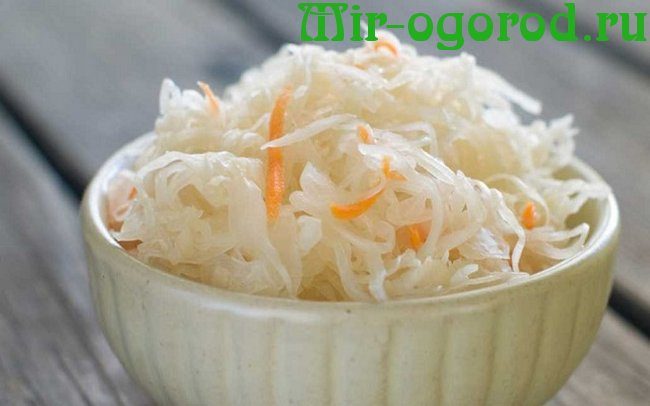
Is this an option for hybrid varieties?
As you may have noticed, some varieties are designated "F1". This means they are hybrid.
My grandmother is still afraid to buy such seeds, believing that they are GMOs. In fact, hybrids are obtained through selection.
Most hybrids do not surprise with their taste immediately after harvest. They need to stay in the basement for at least 3 months. Then they can be consumed. However, the hybrids described above (Geneva, Menza, Jubilee) are a good exception to the general rule. They can be cooked and stored right away.
The most popular hybrid is the F1 Gingerbread Man. Having grown it, take the cabbage to the basement and forget about it for a long time, preferably until May.
But then, when almost all the rest of the cabbage has long become history, these heads of cabbage will be fresh, smooth and juicy. Even if you cook for your family, you can sell it. They can also be salted.
How to salt cabbage to keep it crispy
Delicious sauerkraut must be crispy, but not every housewife knows how to achieve the desired result.And only professionals can share some important secrets of making winter pickles. We will try to talk about them in detail later in the article. The suggested tips and tricks will certainly be useful for beginners and already experienced chefs.
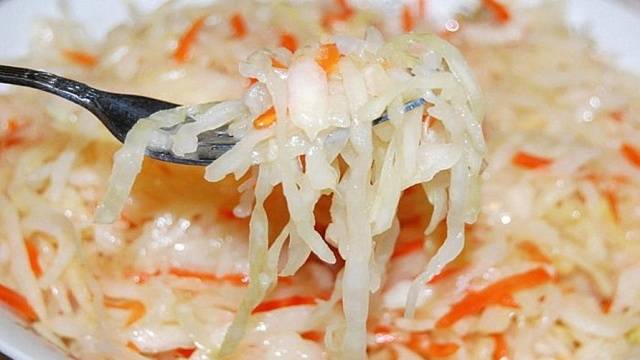

Cooking crispy sauerkraut for the winter
Remove the top leaves from the cabbage heads and cover the dishes with these leaves, in which we will pickle the cabbage. Leave some of the leaves, then close the chopped cabbage on top. Cut the cabbage heads into 4 pieces. Cut the stump and chop the cabbage finely. To do this, use a knife or a special shredder for cabbage.
It is better not to use a food processor for shredding cabbage. Although it chops very quickly, it is too fine. As a result, the cabbage will produce too much juice.
Wash the carrots, peel them, wash them again and cut them into small pieces with a knife. You can, of course, grate the carrots on a coarse grater, but then the cabbage, when salted, will turn orange, since grated carrots release more juice than cut carrots. Therefore, if you want to get delicious sauerkraut of a beautiful white color, then it is better to cut the carrots.
Combine the cabbage, carrots and salt in a large enamel bowl. Squeeze the cabbage so that it gives juice. Fold the cabbage into a prepared container for pickling and tamp with a wooden crush. The cabbage juice should completely cover the cabbage.
When all the cabbage is tamped, close it with the laid-back cabbage leaves, press down on top with a flat plate. Put a load on this plate. In this case, a 3-liter jar is suitable, which must be filled with water.
Stick a clean wooden stick on the side so that gases come out of the cabbage during fermentation. The fermentation process of cabbage should last about three days (but sometimes more) at room temperature.
Several times a day, the cabbage must be pierced with a clean stick in several places. The cabbage will give off a lot of bubbles and foam. If this is not done, then the cabbage will ferment with bitterness.
The foam that forms as a result of fermentation must be removed. When the brine has brightened and the foam has ceased to stand out, then the sauerkraut is ready for use.
Quick salting of cabbage at home in 2 hours


For a 3 liter jar:
- Cabbage - half a large fork - about 2 kg
- Carrots - 200 g
- Bell peppers of different colors - 3 pcs.
- Tomatoes (it is better to take dense oval-shaped) - 2 pcs.
- Garlic - half a head
- Bay leaf, peppercorns - to taste
- Salt - 30g
- Sugar - 40 gr.
- Acetic essence - 1 tbsp. l
- Boiling water - 2 l
Chop the cabbage thinner. Peppers and carrots - sticks. Cut the garlic cloves into 4 pieces. Tomatoes - 8 pieces. Mix everything and fill the jar.
Put spices, sugar and salt in boiling water. Pour into cabbage. Let the salad sit in the brine for 30 minutes.
Drain the can into a saucepan and bring to a boil. Pour the vinegar and again into the cabbage.
Cover with a lid and let cool. After 2 hours, the salting will be ready.
In old cookbooks, there are many simple recipes for salting cabbage in jars for the winter - in one day and in 2 hours. I liked the easiest way and at the same time the fastest cooking cabbage for the winter in liter jars. It is convenient that the composition contains sunflower oil - we opened it and immediately eat it, you don't even need to add anything.
The best varieties of cabbage for storage
On the territory of the Urals, Siberia, the northern regions, winter cabbage varieties for storage are grown through seedlings, which are planted on the beds in late May or early June, when the threat of return frosts has passed. Read about sowing cabbage outdoors.
The most common varieties for long-term storage are:
- The gift ripens in 4 months, tasty round dense heads weighing 4-5 kg do not crack, they are used for salting, pickling. They are stored well and for a long time (more than 5 months);
- The gingerbread man has round dense heads of cabbage weighing about 5 kg, the flesh is yellowish in the cut. The variety is used for pickling, pickling. Stored for several months;
- Moscow late reaches maturity in about 125 days. The variety is high-yielding, the dense heads are very large, have a great taste, and are stored for a long time until spring. The maximum weight of the heads can be up to 20 kg;
- Rusinovka is a high-yielding mid-season variety, moderately resistant to bacteriosis and black leg, dense heads of cabbage taste great fresh and fermented, do not crack;
- The blizzard ripens in 135 days, the heads of cabbage are poured up to 3 kg, dense, very tasty. Cabbage is resistant to temperature extremes and practically does not get sick, resistant to phomosis and black leg. It is good in pickled and pickled form, the taste is excellent. Recommended to grow in the northern regions, the Urals and Siberia.
- Also for these regions, long-stored varieties of white cabbage are suitable: Aros, Geneva, Yubileiny, Türkis, Crumont (it is well stored for more than 6 months and is not affected by necrosis), Amager (it has been noticed that after a certain period of storage it starts to taste bitter).
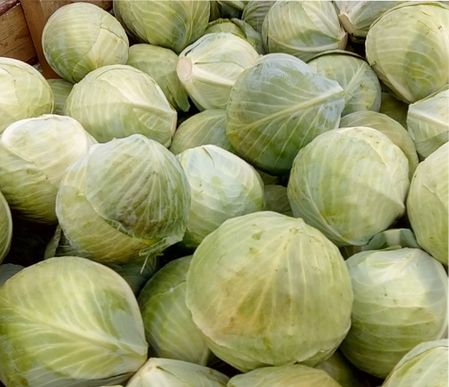

winter cabbage varieties for storage
Hybrids are great storage options
Hybrids specially bred for long-term storage without loss of taste and presentation. There are hybrids that acquire excellent taste after 2-3 months of storage.
The most popular hybrids are shown below.
Wintering 1474 is intended for cultivation in the northern regions, Siberia, the Urals with short and cool summers. She is not afraid of low temperatures and is resistant to fungal pathogens. The most delicious hybrid becomes after four months of storage. He is the champion in shelf life.
Mehndi F1 reaches maturity in 150 days and is stored for a long time. The heads are dense, large, up to 6 kg with excellent taste, white on the cut, suitable for pickling and pickling.
The F1 paradox matures within 140 days and is stored for a long time until May. Dense round heads are poured up to 5 kg, the taste is delicate sweetish.
Storema F1 ripens 4.5 months after seedling germination. Dense heads of cabbage are poured up to 5 kg. A bright, great taste appears after storage for several months. Good when fermented.
Riection F1 reaches maturity in 3.5 months, it is perfectly stored for 7-8 months. The vegetable grows up to two kg in weight.
Muksuma F1 is poured for about 140 days. The heads are dense, round, no more than three kg of weight. The hybrid is excellent in salting and fermentation, resistant to sudden changes in temperature and to most crop diseases.
Saratoga F1 late ripening (150 days). The hybrid is high-yielding, retains its excellent taste for a long time, the average weight is 4 kg.
Late hybrid Furios F1 is poured within 4.5 months. This is a fruitful cabbage with heads weighing about 5 kg, resistant to many diseases, and retains all its useful qualities for a long time. Suitable for fresh and processed consumption.
Counter F1 grows for about 5 months, has excellent taste, good yield and keeping quality even under unfavorable conditions.
In addition to the listed hybrids, the Timiryazev Academy catalog recommends hybrids stored for a long time in the basement for central Russia:
- Albatross F1 late maturity, bacteriosis resistant, blackleg, dormant, used in processing;
- Aros F1 is a high-yielding hybrid, grows well when thickened, excellent taste, sweetness;
- Amtrak F1 is consistently fruitful, ripens amicably, resistant to cracking, fusarium wilt and thrips.
As you can see, it is easy to choose the best varieties of cabbage for storage suitable for your area from the huge assortment of late ripeness crops. I wish you success!
Share with your friends on social networks!
The site is non-commercial, it is developed on the personal funds of the author and your donations. You can help!
(Even a small amount, you can enter any)
(by card, from cell phone, money - select the one you need)
Thank you!
I invite you to the group for "Country Hobbies"
Pour cabbage with aspirin
The main advantage of aspirin is that because of this, cabbage is stored for a very long time. This does not affect the crunch and taste. The recipe was used by grandmothers, and now you will also find out.
Of the ingredients you need:
- cabbage - 1.5 kg;
- carrots - 400 g;
- salt - 1.5 tablespoons;
- granulated sugar - 2 tablespoons;
- vinegar essence - 1 dessert spoon;
- aspirin - 3 tab. on the can.
Cooking time - 30 minutes.
Let's start?
1. Wash and peel the vegetables well.
2. Chop the cabbage, and grate the carrots on a coarse grater. Stir
3. Sterilize the jars with lids.
4. Fill with cabbage. Don't forget to tamp.
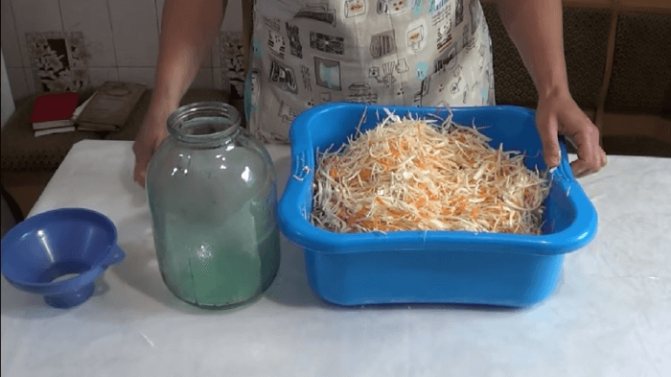

5. Then add sugar and salt. Add vinegar. Pierce the cabbage with a knife to the bottom.
6. Send water to the fire. Boiling water is required here. Then fill the jar to the top. When done, make a few punctures.
7. Place a couple of aspirin tablets in the jar. Pour boiling water over again.
8. It remains to roll up the can.
That's all. When it cools down, put it in a cold place before winter. Bon Appetit.


Tips before salting cabbage.
- Choose the right heads of cabbage. For salting, you should buy medium late or late varieties. Better to use cabbage after the first frost. It will be very juicy and crispy.
- Try to buy no more than 3 kg by weight. The kachan should be tight.
- It is not recommended to use iodized salt when fermenting. Better to buy a large stone. Select the quantity to your taste. However, for a perfect combination, it is recommended to take 1 tbsp. salt per kilogram of the finished dish.
- You should also take a responsible approach to the choice of containers. Use only glass, plastic and enamel containers. Pay special attention to the latter so that there are no chips, cracks and other defects on the inner surface.
- The ideal container is considered to be an oak barrel. Do not use iron or aluminum sourdough trays.
- When fermenting, use only clean tools and containers. You can process them with saline, alcohol or vinegar solution. Also process a cutting board and knife.
- To preserve the maximum vitamins and minerals, the cabbage is cut into large, equal pieces.
- Perfect fermentation requires maintaining the temperature at 15 ° C.
Knowing these simple rules, you will get a great spin for the winter.
Conclusion.
There are many more different salting recipes. Here are the most popular and delicious ones. Having prepared such pickles today, you can crunch it all winter or use it as an additional ingredient in dishes.
Cook with pleasure, choose the right heads of cabbage and other ingredients. Observe the technology of salting, and then you will always have delicious, crispy and healthy twists.
If you still have questions or want to know how to cook this or that dish, then leave your comments below.
Bon appetit, everyone!
Author of the publication
offline 18 minutes
Growing white cabbage
Approaching the growing process of white cabbage, special attention should be paid to the seed and variety, since these are the criteria that are fundamental to a high yield. When choosing a variety, you must first decide on your needs, whether it be salting or pickling, or maybe cooking cabbage soup? Based on your needs, it's not hard to find a variety that meets all your dining needs.
Late-ripening cabbage varieties should be planted with seedlings, for this you need to germinate seeds at home.A small container with good drainage and a specially prepared substrate will serve the purpose. To prepare a mixture for planting cabbage, you will need: turf soil, rotted manure (3: 1), a glass of wood ash for every 8-9 kg. potting soil. Ash is an excellent remedy against rot and fungus.
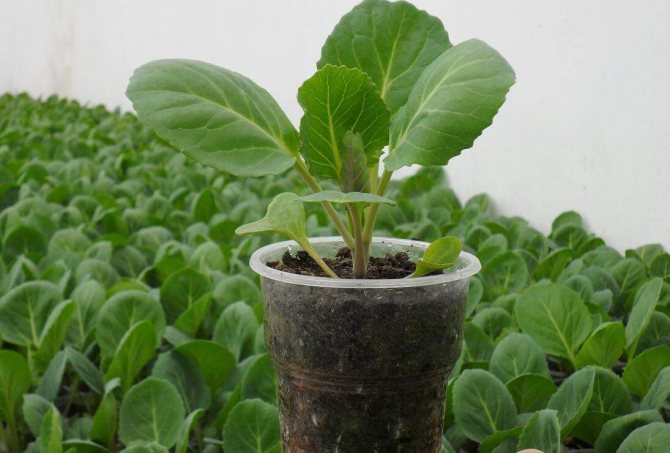

Seeds are planted in prepared containers in February, not thickening and preventing the soil from drying out. The seedling trays should be adequately heated by sunlight or artificial light.
The seedlings will be ready for planting in open ground when they get stronger and grow up, having at least 4 leaves. Cabbage is planted in warm weather, when the soil has warmed up enough, preferably in the evening, so as not to scorch the young leaves.
Planting is carried out in rows or in holes.
The soil is prepared in advance, it is dug up, fertilized with rotted organic matter (a bucket per square meter of land), harrowed and "pushed". Potassium and phosphorus are additionally added to the poor soil.
The seedling is deepened in the hole to the length of the root, gently sprinkling and lightly ramming the soil around the plant. After planting, the seedlings are watered with warm water and shaded for a day to facilitate survival.
The place of cabbage in the crop rotation is after beans, potatoes and carrots.
White-headed does not tolerate acidic soils and swampiness. Before sowing cabbage seeds, the soil is limed a week before the intended sowing, then organic matter (a bucket per square plot), superphosphate (70 g per square meter) are added, and immediately before sowing seeds, the beds are sprinkled with wood ash.
Before sowing, the seeds of white cabbage are hardened, the procedure is not complicated, allowing you to increase germination and resistance to various kinds of fungi.
The seedlings are first immersed in water at a temperature of up to 56 degrees, then cooled in the cold for 5-7 minutes, dried with a paper towel, wrapped in a napkin and placed in the refrigerator for three days.
After the procedures carried out, the seeds can be rinsed with a solution of potassium permanganate and proceed to sowing. The first shoots will appear after one and a half weeks.
The optimal temperature for intensive growth is + 22 degrees.
Cabbage recipe in jars with tomatoes
For cooking, you need small and ripe tomatoes with a dense texture.
Main ingredients:
- cabbage - 10 kg;
- tomatoes - 5 kg;
- salt - 350 grams;
- to taste - dill seeds, currant and cherry leaves, pepper, celery.
Fresh articles about garden and vegetable garden


Cooking recipe: Washed vegetables are chopped. If the tomatoes are small to medium in size, leave them whole. Put chopped cabbage and tomatoes in a large container, salt. Top of the leaves of berries, dill and celery. In this way, three layers of cabbage and a tomato are sandwiched. Cover the salad with gauze or a clean cloth on top and put it under oppression. Fermentation and the release of vegetable juice should be monitored. On the 4th day, the salad is transferred with tomatoes into jars and cooled for 12-15 hours.
- We protect the cottage from mice and other rodents
- How to store dried apples at home?
Category: Cottage
The most unpretentious Chinese cabbage seeds for the lazy
Peking cabbage has been grown in Russia quite recently. Because of the thin, very soft leaves at the edges, many attribute it to salads. In fact, this is a full-fledged representative of the cruciferous group.
Peking cabbage is involved in many culinary recipes - salads, soups, preserves, marinades. Even a beginner will get a good harvest by planting special hybrids:
- Russian size. The hybrid was developed by domestic breeders and gives an excellent yield, even in difficult climatic conditions. The oblong heads weigh up to 4 kg and mature in 75-80 days on any soil.
- Cha cha. The cabbage variety is recommended for use in northern latitudes and in the Urals. From the moment of sowing to the beginning of harvest, only 55 days pass.This period can be shortened if the seedlings are prepared in advance. Medium forks weigh up to three kilograms.
- Orange tangerine. The variety got its name for its unusual "red" heart. The heads ripen in 40 days and turn out to be medium-sized - usually the forks weigh no more than one kilogram. They tolerate frost without any problems, give excellent results when closely spaced in the garden. Seeds can be planted in batches with multiple harvests during the season.
- Nika. The seeds are prepared for planting outdoors or under a film. It is a resistant variety that does not suffer from common diseases. Seedlings give curly light green leaves, which form large three-kilogram heads of cabbage. Dense leaves are used for making salads or stewed.
- Vesnyanka. Many people use this variety to harvest fresh Chinese cabbage faster. Disease-resistant and unpretentious Vesnyanka gives a bountiful harvest in 35 days. Dense heads of cabbage do not crack, consist of juicy, tasty leaves.
How to salt cabbage to keep it crispy
Every housewife wants to know how to ferment cabbage so that it is crispy and tasty.
After all, this blank is a real lifesaver for your table in winter.
You can prepare various vegetable salads and vinaigrettes, pie fillings and, of course, the famous Russian cabbage soup with sauerkraut.
Today we will tell you how to salt cabbage to crunch it, and everyone who tried it complimented your culinary art.


Recipes for harvesting cabbage for the winter
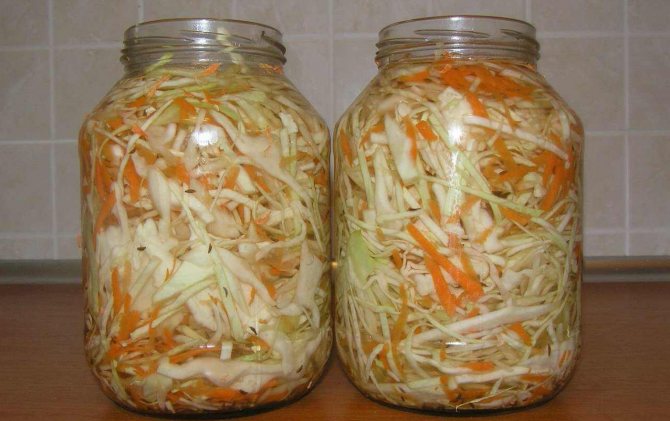

The most common recipes for harvesting white cabbage for the winter were, is and will be its pickling, pickling and pickling. As a mono product, and as part of other vegetables and berries.
A simple sauerkraut recipe
To cook sauerkraut, you need to chop it into strips, repeat the same with carrots, mix vegetables.
Then a strong brine is prepared, salt dissolves in hot water.
After that, already chopped cabbage mixed with carrots is placed in brine, for 10 minutes, squeezed out and transferred to glass jars with a wide neck, for piquancy, you can add bay leaf and dill seeds. For two days, jars covered with gauze are warm, and after a lapse they are taken out into the cold. The cabbage will be ready in 3-5 days.
Pickled cabbage
The head of cabbage is chopped into strips, carrots are chopped on a grater, bell peppers are chopped into rings. Mix the vegetable mass.
Then add allspice peas, lavrushka, nutmeg. For the marinade, you need boiled, hot, salty water (3 tablespoons per liter), a tablespoon of vinegar is added to the brine. A vegetable mixture is placed in the prepared liquid and pressed down with a load for 12 hours. After that, the vegetables are laid out in jars and stored in a cold place.
Salted cabbage recipe for the winter, or Georgian cabbage "option"
Salted cabbage is a great snack on any table. Cabbage is chopped in large pieces, but salted to fit in the jar.
Then add peeled, chopped beets, carrots, bay leaves, garlic and spices to taste. Vegetables are stacked in sterilized jars in layers and poured with strong boiled and cooled marinade (salt, water, vinegar, sugar, sunflower oil). At the end of the day, cabbage can be served on the table, and for the winter the cans are rolled up and stored in a cool place.
How to salt cabbage in a jar to keep it crispy
One of my all-time favorite crispy cabbage recipes is the pellet appetizer. It represents a successful union of cabbage and beets. That is why it turns out not only great taste, but also beautiful color.
Ingredients:
- 2.5 kilograms of fresh cabbage;
- a little more than a liter of water;
- 1 medium beet;
- 2 tablespoons of granulated sugar;
- 1 tablespoon of coarse salt, no iodine or other additives;
- 100 ml vinegar 9%.
Step by step description of the recipe:
- Dissolve salt and granulated sugar in water, stirring as much as possible. Then pour in the vinegar and stir.
- Cut the cabbage into cubes, about 4 * 4 centimeters, after cutting out the stump.
- Peel and cut the beets into 2 pieces. Cut each into thin slices, about 3 centimeters wide.
- Put cabbage in layers in a clean jar, shifting with beet slices. You do not need to wrinkle it with your hands. Tamp lightly so that the salad is not very loose, but not too tight.
- To avoid messing up the table, place the salad jar on a plate. Pour marinade to the top and cover with lids. Leave to marinate in the kitchen for 2 or 3 days.
- The mouth-watering pink snack cans can then be transferred to a cool room for long-term storage.
According to this recipe, cabbage turns out to be sweet and sour and very tasty. Such beauty can be safely put at the head of the festive table and not only.
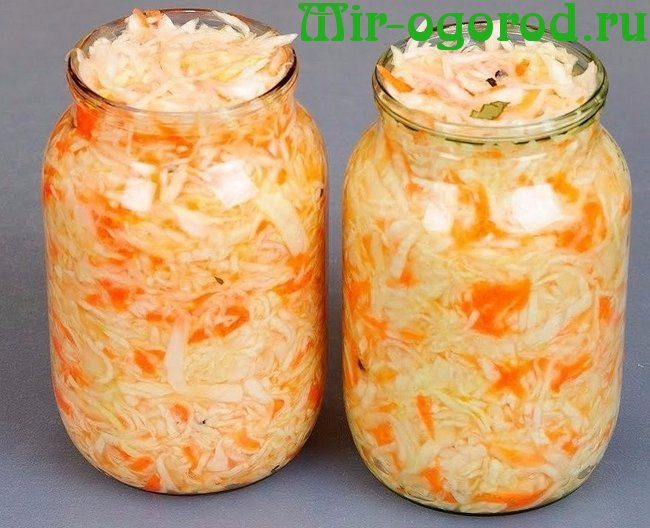

How to choose white cabbage for harvesting
There are a lot of recipes for cooking sauerkraut. But regardless of the recipe, you must choose the right vegetable itself. To do this, you should take into account a few simple recommendations:
- Choose cabbage heads with fresh, not cut or peeled leaves. Since in this case, perhaps the vegetable was already frozen and the spoiled leaves were removed in this way


Fresh head of cabbage
Attention! White cabbage leaves contain more sugar than young and green ones. Namely, sugar is necessary for the fermentation and fermentation of the vegetable.
- Examine the head and stalk of cabbage for brown or black rotted areas, indicating a vegetable infection with fungi or putrefactive bacteria. Such cabbage is unsuitable for harvesting for the winter, and molds themselves are dangerous to health.
- Pay attention to the integrity of the leaves. After all, cabbage, even during the growing period, can be exposed to pests that lay larvae inside the vegetable and eat the cabbage from the inside.
- Choose heads of medium size, small but heavy. In this case, it is necessary to squeeze the head in your hands. If the head of cabbage is tight, it means that the vegetable is mature and has managed to absorb the necessary vitamins and minerals from the soil. The puffy, bulky and light cabbage was cut beforehand and is therefore less useful.
- Young green cabbage, which is often added to salads or first courses in the spring months, is not very useful and is not suitable for preparing sauerkraut for the winter. Such a vegetable cannot be stored for a long time, it is only suitable for quick use.
- The best varieties of cabbage, suitable for pickling for the winter, appear in gardens or in stores only at the beginning of September. Mid-season and mid-late types of white-headed vegetables are suitable for harvesting. After all, it is this cabbage that is considered ideal for sauerkraut, but not suitable for fresh storage.
- Suitable for harvesting, as well as for long-term storage, canning, pickling, heads of cabbage of late varieties. The vegetable has a pleasant taste, retains the maximum amount of minerals and vitamins even after heat treatment.
- If you cannot determine a suitable head of cabbage by its appearance, you can use another method. Cut the head in half, see the color and taste the vegetable. The best vegetable to pickle will be creamy white on the inside when cut and tastes crisp and sweet.
In addition, when choosing which cabbage is suitable for pickling for the winter, you should pay attention to cauliflower, red cabbage, Brussels sprouts and Peking cabbage.
It is desirable that the vegetable is freshly cut, fresh and firm in structure, without damage or signs of rotting. It is this kind of cabbage that is ideal for pickling or pickling.


Red cabbage
White cabbage: what varieties to plant for fermentation and long-term storage


Cabbage accounts for more than a quarter of the total volume of vegetables consumed by humans: it serves as one of the main sources of meeting the needs for vitamins and mineral salts. Of particular value are varieties of late ripening, since most of them are stored for a very long time. Often they also perfectly show themselves in pickling or salting.
Methods for salting cabbage for the winter
Before you start to master the various ways of salting cabbage for the winter, it will be useful to learn the basic tricks of successful salting. So, in order for the taste of pickled cabbage to be excellent, it is better to choose cabbage of later varieties for pickling. In this case, give preference to cabbage without visible damage. The upper dried or sluggish leaves must be removed without fail.
Cabbage can be sliced in a variety of ways. Recently, more and more housewives prefer to use various devices for cutting vegetables, which significantly reduce the time for cutting cabbage. In addition, cabbage shredded in this way will be the same size. If you don't have a vegetable slicer, use an ordinary knife. And in order for the cabbage to be cut quickly and easily, a sharp and convenient knife must be used.
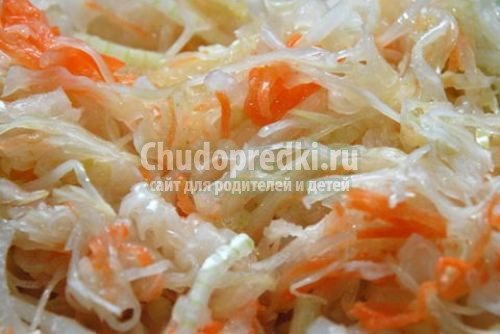

? It is very important to choose the "suitable" salt in order to pickle on cabbage. Many housewives recommend using ordinary stone salt, not iodized or finely ground salt.
When you pour the brine over the shredded cabbage, keep in mind that it should completely cover the cabbage. If you do not have enough brine, just increase the weight that you will put on top.
Little tricks are the key to successful salting
Every year, with the arrival of autumn, the question of how to salt crispy cabbage for the winter becomes relevant. There can be no unequivocal answer to this question, since the fermentation process is quite delicate and even, at first glance, an insignificant factor can adversely affect the safety and souring of cabbage. So, deciding to prepare sauerkraut for the winter, you need to consider the following important points:
Variety selection
Only medium early and late varieties are suitable for salting. Such heads of cabbage are always dense, juicy, large, contain a large amount of sugar, which is actively involved in the fermentation process. Such cabbage can be kept fresh for a long time under certain temperature conditions. Some varieties have a shelf life of 6 and sometimes even 8 months. The sourdough additionally extends the storage period: properly cooked sauerkraut can be stored until the next season.
Among all the variety, such varieties of cabbage as Slava, Valentina, Gift and some others are recognized as the best for salting and long-term winter storage.
Kvasim on the growing moon
Nowadays, few people think about the fact that there are favorable days for pickling cabbage. But in Russia, they were engaged in such processes at a strictly defined time - after October 14, which fell on the feast of the Intercession of the Most Holy Theotokos. In addition, folk signs recommend taking into account the lunar cycle. For example, cabbage is not fermented on a full moon. Best of all, fermentation processes, as our ancestors believed, take place during the growing moon. Whether to follow this rule is up to you. But if you decide to perform pickling cabbage in a jar on a growing moon, then in 2015 these periods fall on the following time intervals: from 18 to 26 February, from 20 March to 4 April, from 19 April to 3 May, etc. In the fall, the moon will grow from October 13 to October 27, and from November 11 to November 26.


So, we found out that in order to most accurately determine the days for pickling cabbage, you should pay attention to the exact time of the onset of one or another phase of the Earth's satellite. ...
Salt cabbage quickly and tasty and in one day


You will need:
- Cabbage - 2.5 kg
- Beets - 0.5 kg
- Garlic - 1 head
- Bitter pepper - 2 cm
- Acetic acid 70% - 1 tbsp
- Salt - 2 tsp
- Sugar - 3 tsp
Cut the cabbage as for borsch, garlic and pepper into thin strips. Grate the beets on a coarse grater. Squeeze a little and put in a jar.
Boil 2 liters of water. Add acid, salt and sugar. Pour the solution slowly into the jar so that it fills all the space between the cabbage.
Sterilize 0.7 L jars in a saucepan. - 20 minutes after boiling water, 1 liter each. - 25 minutes. Roll up sterilized lids.
When we don't want to mess with the brine, we salt the cabbage, pouring cold water over it right from the tap. But, having saved on one, you will have to spend a little more time waiting until the cabbage is salted. Usually (at a temperature in the kitchen of about 20 degrees) it takes a couple of days. But what a result! The cabbage is firm and crispy! Keeps perfectly in the refrigerator.
What kind of cabbage can be used for pickling and pickling
White cabbage of late and medium late ripening is suitable for pickling and salting (Slava, Moscow late, Belorusskaya, Zimovka, Amager, etc.). The heads of cabbage must be at least 700 g, they must be healthy and firm. Savoy and Brussels sprouts are completely unsuitable for these processes. Red cabbage, which is rather rarely grown in our country, ferments well, and it is often mixed with white cabbage to color the final product. The processes of pickling and salting cabbage differ little from each other; and in that, and in another culinary process in general use the same varieties.
Which cabbage is suitable for pickling
The main thing in any recipe is to choose and prepare the right vegetables. Even such a detail as the variety and ripening time can affect the taste of the finished dish. And given that cabbage is salted in the hostess's jars for future use, then this matter should be approached with greater responsibility.
- It is best to choose mid-ripening or late-ripening cabbage for pickling. Early varieties are completely unsuitable for pickling.
- It is important that the heads of cabbage are firm and firm.
- An important factor is the juiciness of the cabbage. Dry and slightly juicy should be set aside.
- The leaves should be tough.
- In no case should you salt frozen vegetables.
- Heads of cabbage must be intact, free from damage, pests or traces of disease.
- To determine if a fork of cabbage is suitable for pickling, squeeze it with your hands. If you hear a characteristic crunch, it means that you have chosen the right main ingredient.
Read also: How to properly freeze plums for the winter in the freezer: all methods of freezing - Susseki


Articles for gardeners and gardeners
Pickling and pickling when to start
Both blanks can be made from mid-autumn.
According to scientists, it is in October that the amount of milk sugars in cabbage of the correct varieties rises to the required level, and the vegetable will be able to correctly "organize" the fermentation process.
If in winter you see that cabbage is poorly in the basement, you can ferment it until February inclusive.
Also, some people believe that it is worth chopping cabbage only when the moon is growing. If there are always clouds in the sky, you can look on the Internet - there you will find the lunar calendar in a matter of minutes.
What is the difference between such procurement methods
- Pickling. The preservative is lactic acid, which is released during fermentation of cabbage.
- Salting. Here you can guess by the name - the most active component of conservation is salt. When salted, cabbage also ferments and becomes sour. But if you put too much salt, it will slow down the fermentation process, and the preparation will fail.
The correct folk recipe for sauerkraut, in which it turns out to be fermented and most useful for us, takes a long time. But we cook not only for the sake of good taste, but also for the sake of good, right?
Especially when you consider that we will eat it at the end of autumn, in the midst of colds, when every vitamin counts. The recipe for such a cabbage is in this video:
And the delicious salting method (of course, also old) is here:
Salting cabbage with cold tap water
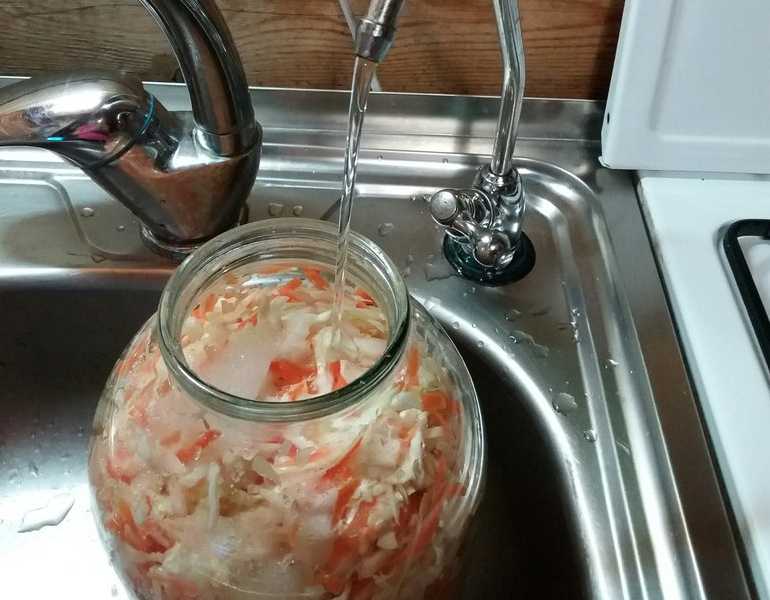

For a three-liter can:
- Cabbage - 2 and a half kg
- Carrots - 1 large
- Salt - 2 tablespoons
Chop the cabbage into long, thin strips. Grind the carrots. Stir, but do not wrinkle - she should not let the juice. Place the vegetable preparation in a jar and press down a little. There is also salt.
Pour the cabbage with cold water (you can immediately from the tap, if you are sure of its quality, but it is better to filter it). Slightly wiggle it with a long stick so that the water reaches the bottom, and the top is under water.
Place the jar in a bowl to collect vegetable juice. Leave warm for 2 days. Return the resulting juice back to the jar. Periodically pierce the cabbage with a stick to the bottom - to release excess air.
After the allotted time, taste it. If you do, then put it in the refrigerator. And if there is no usual acid - let it stand for another day (this is the maximum).
Advice to the hostess: For long and high-quality storage, make sure that all the cabbage is covered with brine. This will help to avoid the appearance of mold on the surface.
Watch the video.
Cauliflower varieties
This type of cabbage is often consumed fresh, added to salads, soups, stews, and stewed. Quite often, blanks are made. For marinades, salting, various dishes, not leaves are taken, but inflorescences. It is very difficult to grow such a crop in open ground. Harvesting largely depends on the selection of a suitable variety of cabbage. Consider the very best varieties of culture.
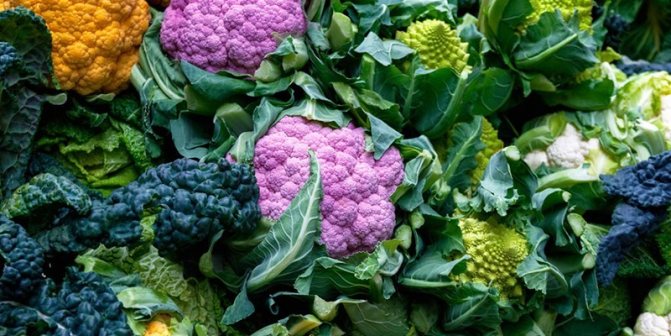

Early
These cauliflower varieties quickly form heads
If you do not want to wait long for the harvest, then pay attention to the best seeds:. Name Characteristics Price in rubles "Movir-74", 0.2 g Ripens 60 days after transplanting
Resistant to cold weather, drought. Inflorescences of a white, yellowish-white hue, weighing up to 1400 g, without bitterness. Due to the short ripening period, the crop can be obtained 2 times per season. There are no downsides. 6 "Snowball 123" or "Snow Globe", 0.5 g Bred by workers of the French selection. The heads are dense, weighing up to 2000 g, without bitterness, ripen in 100 days. Suitable for growing in greenhouses, in the open field. Rarely affected by disease. Minus - it is hard to tolerate drought, lack of fertilizing. 12 Fremont F1, 0.1 g The hybrid was brought out by workers. Heads weighing 1.5 kg are quickly tied, are distinguished by high density, smoothness, excellent taste, ripen 78 days after transplanting to a permanent place. No sprouting upper leaves. There are no downsides. 37
| Name | Characteristics | Price in rubles |
| "Movir-74", 0.2 g | Ripens in 60 days after transplanting. Resistant to cold weather, drought. Inflorescences of a white, yellowish-white hue, weighing up to 1400 g, without bitterness. Due to the short ripening period, the crop can be obtained 2 times per season. There are no downsides. | 6 |
| "Snowball 123" or "Snow globe", 0.5 g | Brought out by workers of the French selection. The heads are dense, weighing up to 2000 g, without bitterness, ripen in 100 days. Suitable for growing in greenhouses, in the open field. Rarely affected by disease. Minus - it is hard to tolerate drought, lack of fertilizing. | 12 |
| Fremont F1, 0.1 g | The hybrid was brought out by the workers. Heads weighing 1.5 kg are quickly tied, are distinguished by high density, smoothness, excellent taste, ripen 78 days after transplanting to a permanent place. No sprouting upper leaves. There are no downsides. | 37 |
Mid-season
The average ripening period for such cabbage is 120 days. It is recommended to choose the best cabbage varieties:
| Name | Characteristics | Price in rubles |
| "Parisian", 0.5 g | Easily tolerates cold, dense, white heads, weighing 2 kg, excellent taste. Ripening - 90 days from the date of transplanting. Suitable for summer and autumn cultivation. Can be salted, consumed fresh. There are no downsides. | 8 |
| "Purple ball", 0.15 g | Ripening time - 118 days.The heads are rich in anthocyanins, dense, decorative, violet-purple in color, not covered with leaves, weighing 1.5 kg, without bitterness. There are no disadvantages. | 18 |
| "Amerigo F1", 0.3 g | The growing season is 85 days from the moment of transplantation, the weight of the yellow-green head is 2.5 kg, without bitterness. Differs in intensive development. It tolerates heat well, early frosts. One of the best hybrids for fresh implementation, blanks. Needs frequent mineral nutrition. | 8 |
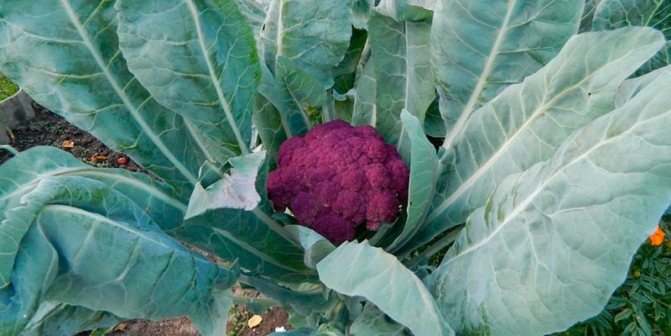

Late
Harvesting is done in late autumn - mid or late September. Some heads can be cut off in the first days of September. The best cabbage varieties are Lennox, Megaton F1, and the following:
| Name | Characteristics | Price in rubles |
| Skywalker F1, 0.1 g | The ripening period is 90 days. Productivity - 6 kg / sq. m. Differs in dense heads of 3 kg, which are covered with leaves. The taste is fresh and pleasant. The downside is the high cost of seeds. | 68 |
| Cortez, 0.1 g | Brought out by workers at the Dutch farm Syngenta. The ripening time is 75 days. The heads are covered with leaves and weigh 2 kg. The pulp is juicy, of excellent taste. There are no downsides. | 45 |
Cabbage is an aggressor for pickling. Description and characteristics of the variety
The aggressor is a relatively young variety of cabbage, bred by employees of the breeding company, Holland, in 2003. In the same year, the plant was included in the state register of the Russian Federation as a vegetable crop recommended for cultivation in the central regions.
The F1 hybrid is a late-ripening variety that can be harvested 115–130 days after transplanting. The fruits of the culture are large, rounded, slightly flattened on top, dense forks. The length of the stalk is from 15 to 20 cm. The leaf rosette is large, with small round-shaped leaves raised above the soil and having a gray-green color. The internal structure is thin, but dense, white with a yellowish tinge. The leaves are characterized by pleasant taste, juicy.


If you follow the basic rules of agricultural technology, you can grow heads of cabbage weighing 3-5 kg. From one hectare, you can get about 450-600 centners of fruit. A record harvest was recorded in the Moscow region and amounted to 800 centners.
The output of marketable products is high and amounts to 92–96%. Subject to the necessary storage rules, cabbage is able to preserve its taste and aesthetic characteristics for 5-6 months.
Did you know? To this day, the wild-growing ancestor of garden cabbage has not been established. For the right to be called the homeland of culture, Georgia, Greece and Italy have been fighting for many centuries.
A feature of the Aggressor variety is its excellent resistance to adverse environmental conditions. Cabbage perfectly tolerates a bad climate, a deficiency of nitrogen nutrition, and does not require special care.
Is it possible to take medium grades
Yes, but not everyone. Moreover, it is worth cutting most of them without delaying - not in late winter, but already now, in the fall.
Present
A very successful variety: the harvested crop can lie in the cellar for six months. If you ferment the cabbage, you can do it in large quantities at once: the preparation will be tasty and will not oxyderate for 5 months. You can cut it both in the fall and in the first month of winter.
This variety can be recognized by greenish, but more often - white, as if waxed heads. Their weight is up to 4.5 kg. The dignity of the variety is also that the heads are juicy, practically do not crack. And scientists say that such a variety is the leader in vitamin C.
True, to grow this cabbage, you need to make a lot of effort - the Gift loves abundant watering, fertilizers and frequent furrowing of the soil.


Glory 1305
Probably the most famous mid-season variety: it is fruitful, heads of cabbage grow from 3 to 5 kg.
You can pick and chop cabbage in September. But if you do not rush and keep the heads of cabbage in the beds right up to frost, they will become juicier and sweeter.
Slava is stored for about 3 months.


Dobrovodskaya
A variety with large, strong, juicy heads.
They are good for any dishes - both for preparations and for ordinary folk cooking (cabbage rolls, borscht, cabbage soup, salads).
This variety is very fond of feeding. He responds especially well to saltpeter.
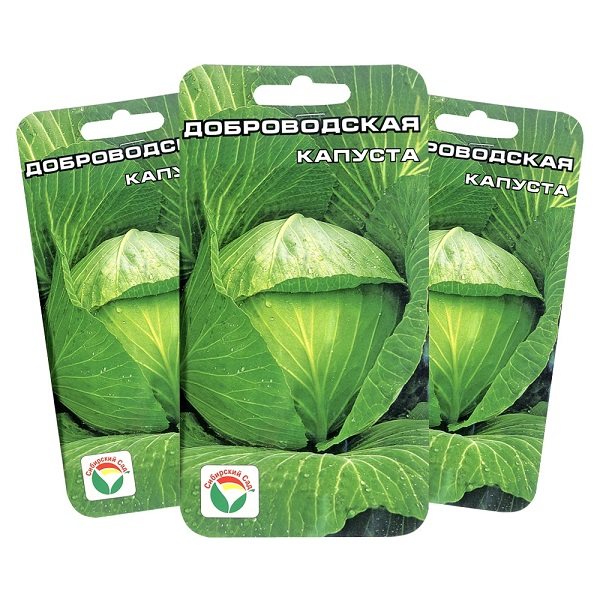

Menza F1
Gulliver among cabbage: Menza's heads grow up to 9 kg. They are waxed, gray-green, with leaves slightly wavy at the edges.
In the beds, the variety grows well, it is not afraid of bad weather.
In the basement, it will last until the first months of spring. If you want the cabbage to last until summer, ferment it in the middle of winter.


Anniversary F1
The heads of cabbage do not grow small - up to 4 kg.
You can store the crop for a relatively long time - about 5 months.
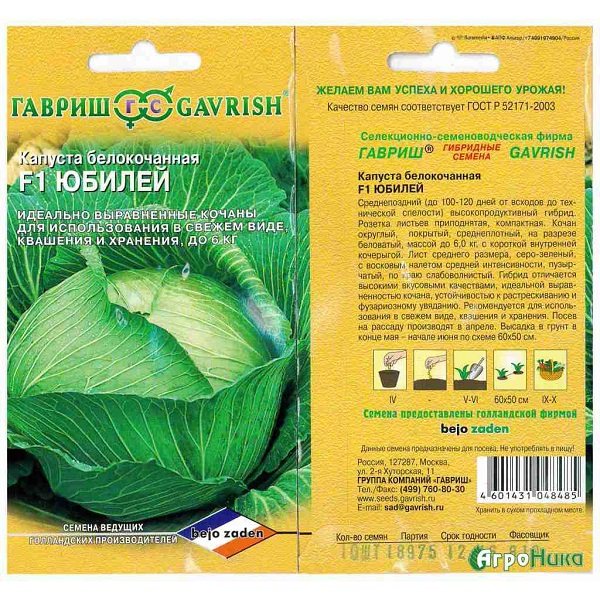

Reviews about varieties
In the Moscow region, the growing conditions, I do not think, are worse than in Siberia. I opted for the Kolobok cabbage. Unpretentious, small, very dense heads of cabbage, perfectly stored, and sauerkraut is good, and so ...
Nikola 1
I really like the variety Valentine. True, we did not try to ferment it, but it is stored just fine - until March-April at least, while the taste and aroma do not deteriorate at all, in the spring when you cut a head of cabbage, it feels like you just cut it down from the garden. Recently, I have only planted it on my seedlings, the seeds of Langedeker and Zimovka have been untouched for a year.
Penzyak
Aggressor cabbage is not small, 3-5 kg, one of the delicious juicy varieties. The centurion did not plant, so I cannot compare, in my conditions (small cellar) it is very difficult to preserve cabbage later than May, but sometimes it is possible ... Valentine is stored without problems, the same Aggressor last year was preserved until the end of April, not without cleaning the upper leaves, of course , but anyway…
Elena
Kolobok planted for several years. Seemed a bit harsh when fermented. Then I switched to the Gift. Not a bad cabbage, but too large heads of cabbage - up to 9 kg. You take a head of cabbage - you don't use it right away, the rest dries up and becomes unusable.
Nick It's me
I also liked the varieties of cabbage Kolobok and Podarok, they really grow very good. Last year I tried to plant the variety Nadezhda, I did not like it at all, I will not plant it anymore, a burdock grows, it takes up a lot of space, and very small heads of cabbage are tied.
Chichichi
The best variety for sauerkraut is Slava. This cabbage is juicy and sweet. There is no need to wait for frost. Cabbage varieties not suitable for pickling, usually with tough thin leaves, not juicy. Unfortunately, a lot of such cabbage has now appeared. Imported varieties are usually all like that, since such cabbage is well stored.
Read also: Is it possible to give rabbits corn (grain, leaves)
Yulia
Varieties and hybrids of white cabbage that are stored for a long time in the cellar are usually well suited for fermentation - there are few exceptions here. Such varieties ripen late, or at least not earlier than September. Most varieties are suitable for a variety of climatic conditions, but it is better to choose zoned ones so that the cultivation of cabbage goes without unnecessary surprises.


